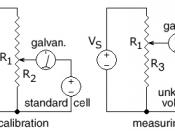An experiment to investigate the factors which affect Resistance in a wire
What is resistance?
A potential difference (V) applied across a wire of length (l), there is in the conductor, an electric field (E). In this electric field the free electrons are not however under continuous acceleration (Ee/m). This is because they repeatedly collide with the moderately massive vibrating atoms losing their kinetic energy. The vibrating atoms having gained this kinetic energy now vibrate more. The resulting increase in the average vibration kinetic energy is rise in temperature.
Movement of charge carriers in any medium must necessarily be subject to such collisions causing loss of kinetic energy and generating heat in the medium. This heating of the medium due to the passage of charge carriers is a general property of all materials and is due to the resistance offered by the material to the flow of charge. The resistance of any material is measured as the potential difference required per unit current in that material.
Hence the resistance (R) is determined as:
Where (V) is the applied potential difference and (I) the current in the material It should be noted that all materials require to have a potential difference applied in order to maintain an electric current in the material. Consequently all materials have resistance. Some materials become more heated than others despite the same rate of flow of charge.
Energy is required to push the charged particles around the circuit. The circuit itself can resist the flow of particles if the wires in the circuit are very thin and very long. For example, a filament in an electric light bulb is extremely thin and incredibly long. Due to the resistance, energy is given out as heat and light. Numerous household appliances, such as electric heaters, hair dryers, toasters,


